Extreme Environment Sensing Using Femtosecond Laser-Inscribed Fiber Bragg Gratings
Abstract
:1. Introduction
2. Femtosecond Laser Induced FBGs
2.1. Mechanisms for Femtosecond Laser Induced Index Change
2.1.1. Formation of the Free Electron Plasma
2.1.2. Induced Index Change Regimes
Smooth or Type I Refractive Index Change
Birefringent Refractive Index Change (Type II)
Void Formation
2.2. Femtosecond Laser-Based FBG Inscription Techniques
2.2.1. Bulk Interferometers
2.2.2. Point-by-Point Grating Inscription
2.2.3. Phase Mask
Phase Mask Longitudinal and Transversal Order Walk-Off
2.2.4. Phase Mask Bragg Resonance Tuning for Distributed FBG Array Fabrication
3. Applications of fs-Laser Induced FBGs for Sensing
3.1. High Temperature
3.1.1. Oxy-Fuel Fluidized Bed Combustor Monitoring
3.1.2. Gas Turbine Combustor Simulator Monitoring
3.1.3. Type II FBGs in Fiber Canes
3.1.4. Type II FBGs in Microstructured Fibers
3.1.5. Sapphire FBGs
3.2. High Ionizing Radiation Environment
3.3. Multiparameter Sensing in Harsh Environments
3.4. High Pressure
3.5. Through-the-Coating (TTC) FBG Inscription for High-Strain Measurements
3.6. FBGs for Shockwave Detection in Energetic Materials
3.7. Sensing with fs-FBG-Based Fiber Lasers
4. Conclusions
Conflicts of Interest
References
- Kersey, A.D.; Davis, M.A.; Patrick, H.J.; LeBlanc, M.; Koo, K.P.; Askins, C.G.; Putnam, M.A.; Friebele, E.J. Fiber grating sensors. J. Lightwave Technol. 1997, 15, 1442–1463. [Google Scholar] [CrossRef]
- Hill, K.O.; Meltz, G. Fiber Bragg grating technology fundamentals and overview. J. Lightwave Technol. 1997, 15, 1263–1276. [Google Scholar] [CrossRef]
- Meltz, G.; Morey, W.W.; Glenn, W.H. Formation of Bragg Gratings in Optical Fibers by a Transverse Holographic Method. Opt. Lett. 1989, 14, 823–825. [Google Scholar] [CrossRef] [PubMed]
- Poumellec, B.; Niay, P.; Douay, M.; Bayon, J.F. The UV-induced refractive index grating in Ge:SiO2 preforms: Additional CW experiments and the macroscopic origin of the change in index. J. Phys. D Appl. Phys. 1996, 29, 1842–1856. [Google Scholar] [CrossRef]
- Erdogan, T.; Mizrah, V.; Lemaire, P.J.; Monroe, D. Decay of ultraviolet-induced fiber Bragg gratings. J. Appl. Phys. 1994, 76, 73–80. [Google Scholar] [CrossRef]
- Mihailov, S.J.; Grobnic, D.; Smelser, C.W.; Lu, P.; Walker, R.B.; Ding, H. Bragg grating inscription in various optical fibers with femtosecond infrared lasers and a phase mask. Opt. Mater. Express 2011, 1, 754–765. [Google Scholar] [CrossRef]
- Zagorulko, K.A.; Kryukov, P.G.; Larionov, Y.V.; Rybaltovsky, A.A.; Dianov, E.M.; Chekalin, S.V.; Matveets, Y.A.; Kompanets, V.O. Fabrication of fiber Bragg gratings with 267 nm femtosecond radiation. Opt. Express 2004, 12, 5996–6001. [Google Scholar] [CrossRef] [PubMed]
- Bernier, M.; Vallée, R.; Morasse, B.; Desrosiers, C.; Saliminia, A.; Sheng, Y. Ytterbium fiber laser based on first-order fiber Bragg gratings written with 400 nm femtosecond pulses and a phase-mask. Opt. Express 2009, 17, 18887–18893. [Google Scholar] [CrossRef] [PubMed]
- Nikogosyan, D.N. Multi-photon high-excitation-energy approach to fibre grating inscription. Meas. Sci. Technol. 2007, 18, R1–R29. [Google Scholar] [CrossRef]
- Thomas, J.; Voigtlander, C.; Becker, R.G.; Richter, D.; Tunnermann, A.; Nolte, S. Femtosecond pulse written fiber gratings: A new avenue to integrated fiber technology. Laser Photonics Rev. 2012, 6, 709–723. [Google Scholar] [CrossRef]
- Berghmans, F.; Geernaert, T.; Baghdasaryan, T.; Thienpont, H. Challenges in the fabrication of fibre Bragg gratings in silica and polymer microstructured optical fibres. Laser Photonics Rev. 2014, 8, 27–52. [Google Scholar] [CrossRef]
- Canning, J. Fibre gratings and devices for sensors and lasers. Laser Photonics Rev. 2008, 2, 275–289. [Google Scholar] [CrossRef]
- Mihailov, S.J. Fiber Bragg grating sensors for harsh environments. Sensors 2012, 12, 1898–1918. [Google Scholar] [CrossRef] [PubMed]
- Mihailov, S.J.; Smelser, C.W.; Lu, P.; Walker, R.B.; Grobnic, D.; Ding, H.; Henderson, G.; Unruh, J. Fiber Bragg gratings made with a phase mask and 800-nm femtosecond radiation. Opt. Lett. 2003, 28, 995–997. [Google Scholar] [CrossRef] [PubMed]
- Davis, K.M.; Miura, K.; Sugimoto, N.; Hirao, K. Writing waveguides in glass with a femtosecond laser. Opt. Lett. 1996, 21, 1729–1731. [Google Scholar] [CrossRef] [PubMed]
- Stuart, B.C.; Feit, M.D.; Herman, S.; Rubenchik, A.M.; Shore, B.W.; Perry, M.D. Optical Ablation by high-power short-pulse lasers. J. Opt. Soc. Am. B 1996, 13, 459–468. [Google Scholar] [CrossRef]
- Schaffer, C.B.; Brodeur, A.; Mazur, E. Laser-induced breakdown and damage in bulk transparent materials induced by tightly focused femtosecond laser pulses. Meas. Sci. Technol. 2001, 12, 1784–1794. [Google Scholar] [CrossRef]
- Sudrie, L.; Franco, M.; Prade, B.; Mysyrowicz, A. Study of damage in fused silica induced by ultra-short IR laser pulses. Opt. Commun. 2001, 191, 333–339. [Google Scholar] [CrossRef]
- Sudrie, L.; Franco, M.; Prade, B.; Mysyrowicz, A. Writing of permanent birefringent microlayers in bulk fused silica with femtosecond laser pulses. Opt. Commun. 1999, 171, 279–284. [Google Scholar] [CrossRef]
- Shimotsuma, Y.; Kazansky, P.G.; Qiu, J.; Hirao, K. Self-Organized Nanogratings in Glass Irradiated by Ultrashort Light Pulses. Phys. Rev. Lett. 2003, 91, 7405–7508. [Google Scholar] [CrossRef] [PubMed]
- Bricchi, E.; Kazansky, P.G. Extraordinary stability of anisotropic femtosecond direct-written structures embedded in silica glass. Appl. Phys. Lett. 2006, 88. [Google Scholar] [CrossRef]
- Glezer, E.N.; Mazur, E. Ultrafast-laser driven micro-explosions in transparent materials. Appl. Phys. Lett. 1997, 71, 882–884. [Google Scholar] [CrossRef]
- Taylor, R.; Hnatovsky, C.; Simova, E. Applications of femtosecond laser induced self-organized planar nanocracks inside fused silica glass. Laser Photonics Rev. 2008, 2, 26–46. [Google Scholar] [CrossRef]
- Poumellec, B.; Lancry, M.; Chahid-Erraji, A.; Kazansky, P.G. Modification thresholds in femtosecond laser processing of pure silica: Review of dependencies on laser parameters. Opt. Mater. Express 2011, 1, 766–782. [Google Scholar] [CrossRef]
- Lancry, M.; Poumellec, B.; Chahid-Erraji, A.; Beresna, M.; Kazansky, P.G. Dependence of the femtosecond laser refractive index change thresholds on the chemical composition of doped-silica glasses. Opt. Mater. Express 2011, 1, 711–723. [Google Scholar] [CrossRef]
- Canning, J.; Lancry, M.; Cook, K.; Weickman, A.; Brisset, F.; Poumellec, B. Anatomy of a femtosecond laser processed silica waveguide. Opt. Mater. Express 2011, 1, 998–1008. [Google Scholar] [CrossRef]
- Hnatovsky, C.; Taylor, R.S.; Rajeev, P.P.; Simova, E.; Bhardwaj, V.R.; Rayner, D.M.; Corkum, P.B. Pulse duration dependence of femtosecond-laser-fabricated nanogratings in fused silica. Appl. Phys. Lett. 2005, 87. [Google Scholar] [CrossRef]
- Chan, J.W.; Huser, T.; Risbud, S.; Krol, D.M. Structural changes in fused silica after exposure to focused femtosecond laser pulses. Opt. Lett. 2001, 26, 1726–1728. [Google Scholar] [CrossRef] [PubMed]
- Reichman, W.J.; Chan, J.W.; Smelser, C.W.; Mihailov, S.J.; Krol, D.M. Spectroscopic characterization of different femtosecond laser modification regimes in fused silica. J. Opt. Soc. Am. B 2007, 24, 1627–1632. [Google Scholar] [CrossRef]
- Smelser, C.W.; Mihailov, S.J.; Grobnic, D. Formation of Type I-IR and Type II-IR gratings with an ultrafast IR laser and a phase mask. Opt. Express 2005, 13, 5377–5386. [Google Scholar] [CrossRef] [PubMed]
- Nishii, J.; Kitamura, N.; Yamanaka, H.; Hosono, H.; Kawazoe, H. Ultraviolet-radiation-induced chemical reactions through one- and two-photon absorption process in GeO2-SiO2 glasses. Opt. Lett. 1995, 20, 1184–1186. [Google Scholar] [CrossRef] [PubMed]
- Smelser, C.W.; Mihailov, S.J.; Grobnic, D. Hydrogen loading for fiber grating writing with a femtosecond laser and a phase mask. Opt. Lett. 2004, 29, 2127–2129. [Google Scholar] [CrossRef] [PubMed]
- Bhardwaj, V.R.; Simova, E.; Rajeev, P.P.; Hnatovsky, C.; Taylor, R.S.; Rayner, D.M.; Corkum, P.B. Optically Produced Arrays of Planar Nanostructures inside Fused Silica. Phys. Rev. Lett. 2006, 96. [Google Scholar] [CrossRef] [PubMed]
- Hnatovsky, C.; Taylor, R.S.; Simova, E.; Rajeev, P.P.; Rayner, D.M.; Bhardwaj, V.R.; Corkum, P.B. Fabrication of microchannels in glass using focused femtosecond laser radiation and selective chemical etching. Appl. Phys. A 2006, 84, 47–61. [Google Scholar] [CrossRef]
- Zimmermann, F.; Lancry, M.; Plech, A.; Richter, S.; Hari Babu, B.; Poumellec, B.; Tünnermann, A.; Nolte, S. Femtosecond laser written nanostructures in Ge-doped glasses. Opt. Lett. 2016, 41, 1161–1164. [Google Scholar] [CrossRef] [PubMed]
- Rysman, J.-F.; Nikogosyan, D.N. Thermal sensitivity studies of fibre Bragg gratings inscribed by high-intensity femtosecond UV laser pulses. Opt. Commun. 2009, 282, 1120–1122. [Google Scholar] [CrossRef]
- Juodkazis, S.; Misawa, H.; Hashimoto, T.; Gamaly, E.G.; Luther-Davies, B. Laser-induced microexplosion confined in a bulk of silica: Formation of nanovoids. Appl. Phys. Lett. 2006, 88. [Google Scholar] [CrossRef]
- Kawamura, K.-I.; Sarukura, N.; Hirano, M.; Hosono, H. Holographic encoding of fine-pitched micrograting structures in amorphous SiO2 thin films on silicon by a single femtosecond laser pulse. Appl. Phys. Lett. 2001, 78, 1038–1040. [Google Scholar] [CrossRef]
- Wang, Y.; Grant, J.; Sharma, A.; Myers, G. Modified Talbot interferometer for fabrication of fiber-optic grating filter over a wide range of Bragg wavelength and bandwidth using a single phase mask. J. Lightwave Technol. 2001, 19, 1569–1573. [Google Scholar] [CrossRef]
- Becker, M.; Bergmann, J.; Brückner, S.; Franke, M.; Lindner, E.; Rothhardt, M.W.; Bartelt, H. Fiber Bragg grating inscription combining DUV sub-picosecond laser pulses and two-beam interferometry. Opt. Express 2008, 16, 19169–19178. [Google Scholar] [CrossRef] [PubMed]
- Martinez, A.; Dubov, M.; Khrushchev, I.; Bennion, I. Direct writing of fibre Bragg gratings by femtosecond laser. Electron. Lett. 2004, 40, 1170–1172. [Google Scholar] [CrossRef]
- Martinez, A.; Khrushchev, I.Y.; Bennion, I. Thermal properties of fibre Bragg gratings inscribed point-by-point by infrared femtosecond laser. Electron. Lett. 2005, 41, 176–178. [Google Scholar] [CrossRef]
- Zhou, K.; Dubov, M.; Mou, C.; Zhang, L.; Mezentsev, V.K.; Bennion, I. Line-by-Line Fiber Bragg Grating Made by Femtosecond Laser. IEEE Photonics Technol. Lett. 2010, 22, 1190–1192. [Google Scholar] [CrossRef]
- Williams, R.J.; Krämer, R.G.; Nolte, S.; Withford, M.J. Femtosecond direct-writing of low-loss fiber Bragg gratings using a continuous core-scanning technique. Opt. Lett. 2013, 38, 1918–1920. [Google Scholar] [CrossRef] [PubMed]
- Dyer, P.E.; Farley, R.J.; Giedl, R. Analysis of grating formation with excimer laser irradiated phase masks. Opt. Commun. 1995, 115, 327–334. [Google Scholar] [CrossRef]
- Xie, W.X.; Douay, M.; Bernage, P.; Niay, P.; Bayon, J.F.; Georges, T. Second order diffraction efficiency of Bragg gratings written within germanosilicate fibres. Opt. Commun. 1993, 101, 85–91. [Google Scholar] [CrossRef]
- Smelser, C.W.; Mihailov, S.J.; Grobnic, D. Characterization of Fourier components in type I infrared ultrafast laser induced fiber Bragg gratings. Opt. Lett. 2007, 32, 1453–1455. [Google Scholar] [CrossRef] [PubMed]
- Smelser, C.W.; Mihailov, S.J.; Grobnic, D.; Lu, P.; Walker, R.B.; Ding, H.; Dai, X. Multiple-beam interference patterns in optical fiber generated with ultrafast pulses and a phase mask. Opt. Lett. 2004, 29, 1458–1460. [Google Scholar] [CrossRef] [PubMed]
- Mills, J.D.; Hillman, C.W.J.; Blott, B.H.; Brocklesby, W.S. Imaging of free-space interference patterns used to manufacture fiber Bragg gratings. Appl. Opt. 2000, 39, 6128–6135. [Google Scholar] [CrossRef] [PubMed]
- Smelser, C.W.; Grobnic, D.; Mihailov, S.J. Generation of pure two-beam interference grating structures in an optical fiber with a femtosecond infrared source and a phase mask. Opt. Lett. 2004, 29, 1730–1732. [Google Scholar] [CrossRef] [PubMed]
- Marshall, G.D.; Williams, R.J.; Jovanovic, N.; Steel, M.J.; Withford, M.J. Point-by-point written fiber-Bragg gratings and their application in complex grating designs. Opt. Express 2010, 18, 19844–19859. [Google Scholar] [CrossRef] [PubMed]
- Zhang, Q.; Brown, D.A.; Reinhart, L.; Morse, T.F.; Wang, J.Q.; Xiao, G. Tuning Bragg Wavelength by Writing Gratings on Prestrained Fibers. IEEE Photonics Technol. Lett. 1994, 6, 839–841. [Google Scholar] [CrossRef]
- Prohaska, J.D.; Snitzer, E.; Rishton, S.; Boegli, V. Magnification of Mask Fabricated Fibre Bragg Gratings. Electron. Lett. 1993, 29, 1614–1615. [Google Scholar] [CrossRef]
- Voigtländer, C.; Becker, R.G.; Thomas, J.; Richter, D.; Singh, A.; Tünnermann, A.; Nolte, S. Ultrashort pulse inscription of tailored fiber Bragg gratings with a phase mask and a deformed wavefront. Opt. Mater. Express 2011, 1, 633–642. [Google Scholar] [CrossRef]
- Song, C.-W.; Zhang, Y.-J.; Wang, Y.; Ju, Y.-L. Tunable Direct Writing of FBGs into a Non-Photosensitive Tm-Doped Fiber Core with an fs Laser and Phase Mask. Chin. Phys. Lett. 2009, 26. [Google Scholar] [CrossRef]
- Voigtländer, C.; Krämer, R.G.; Goebel, T.A.; Richter, D.; Nolte, S. Variable wavefront tuning with a SLM for tailored femtosecond fiber Bragg grating inscription. Opt. Lett. 2016, 41, 17–20. [Google Scholar] [CrossRef] [PubMed]
- Goebel, T.A.; Voigtländer, C.; Krämer, R.G.; Richter, D.; Heck, M.; Siems, M.P.; Matzdorf, C.; Reinlein, C.; Appelfelder, M.; Schreiber, T.; et al. Flexible femtosecond inscription of fiber Bragg gratings by an optimized deformable mirror. Opt. Lett. 2017, 42, 4215–4218. [Google Scholar] [CrossRef] [PubMed]
- Dragomir, A.; Nikogosyan, D.N.; Zagorulko, K.A.; Kryukov, P.G.; Dianov, E.M. Inscription of fiber Bragg gratings by ultraviolet femtosecond radiation. Opt. Lett. 2003, 28, 2171–2173. [Google Scholar] [CrossRef] [PubMed]
- Staveley, C.B. Chapter 10 Fiber Bragg grating sensors in energy applications. In Fiber Bragg Grating Sensors: Recent Advancements, Industrial Applications and Market Exploitation; Cusano, A., Cutolo, A., Albert, J., Eds.; Betham Science: Sharjah, UAE, 2011. [Google Scholar] [CrossRef]
- Sanders, P.E. Fiber-optic sensors: Playing both sides of the energy equation. Opt. Photonics News 2011, 22, 36–42. [Google Scholar] [CrossRef]
- Albert, J.; Fokine, M.; Margulis, W. Grating formation in pure silica-core fibers. Opt. Lett. 2002, 27, 809–811. [Google Scholar] [CrossRef] [PubMed]
- Mihailov, S.J.; Smelser, C.W.; Grobnic, D.; Walker, R.B.; Lu, P.; Ding, H.; Unruh, J. Bragg Gratings Written in All-SiO2 and Ge-Doped Core Fibers with 800-nm Femtosecond Radiation and a Phase Mask. J. Lightwave Technol. 2004, 22, 94–100. [Google Scholar] [CrossRef]
- Huang, Z.; Pickrell, G.; Xu, J.; Wang, Y.; Zhang, Y.; Wang, A. Sapphire temperature sensor coal gasifier field test. Proc. SPIE 2004, 5590, 27–36. [Google Scholar]
- Grobnic, D.; Smelser, C.W.; Mihailov, S.J.; Walker, R.B. Long-term thermal stability tests at 1000 °C of silica fibre Bragg gratings made with ultrafast laser radiation. Meas. Sci. Technol. 2006, 17, 1009–1013. [Google Scholar] [CrossRef]
- Grobnic, D.; Smelser, C.W.; Mihailov, S.J.; Walker, R.B.; Lu, P. Fiber Bragg gratings with suppressed cladding modes made in SMF-28 with a femtosecond IR laser and a phase mask. IEEE Photonics Technol. Lett. 2004, 16, 1864–1866. [Google Scholar] [CrossRef]
- Li, Y.; Yang, M.; Wang, D.N.; Lu, J.; Sun, T.; Grattan, K.T. Fiber Bragg gratings with enhanced thermal stability by residual stress relaxation. Opt. Express 2009, 17, 19785–19790. [Google Scholar] [CrossRef] [PubMed]
- Hnatovsky, C.; Grobnic, D.; Coulas, D.; Barnes, M.; Mihailov, S.J. Self-organized nanostructure formation during femtosecond-laser inscription of fiber Bragg gratings. Opt. Lett. 2017, 42, 399–402. [Google Scholar] [CrossRef] [PubMed]
- Grobnic, D.; Hnatovsky, C.; Mihailov, S.J. Low loss Type II regenerative Bragg gratings made with ultrafast radiation. Opt. Express 2016, 24, 28704–28712. [Google Scholar] [CrossRef] [PubMed]
- Figueroa, J.D.; Fout, T.; Plasynski, S.; McIlvried, H.; Srivastava, R.D. Advances in CO2 capture technology—The U.S. Department of Energy’s Carbon Sequestration Program. Int. J. Greenh. Gas Control 2008, 2, 9–20. [Google Scholar] [CrossRef]
- Walker, R.B.; Ding, H.; Coulas, D.; Grobnic, D.; Mihailov, S.J.; Duschesne, M.A.; Hughes, R.W.; McCalden, D.J.; Burchat, R. Entrained-flow gasifier and fluidized-bed combustor temperature monitoring using arrays of fs-IR written fiber Bragg gratings. Proc. SPIE 2015, 9634. [Google Scholar] [CrossRef]
- Walker, R.B.; Ding, H.; Coulas, D.; Grobnic, D.; Lu, P.; Mihailov, S.J.; Duschesne, M.A.; Hughes, R.W.; McCalden, D.J.; Burchat, R.; et al. High temperature monitoring of an oxy-fuel fluidized bed combustor using femtosecond infrared laser written fiber Bragg gratings. Proc. SPIE 2016, 9754. [Google Scholar] [CrossRef]
- Walker, R.B.; Yun, S.; Ding, H.; Charbonneau, M.; Coulas, D.; Ramachandran, N.; Mihailov, S.J. High resolution, fast temperature mapping of a gas turbine combustor simulator with femtosecond infrared laser written fiber Bragg gratings. Proc. SPIE 2017, 10117, 10117–10155. [Google Scholar]
- Childs, P.; Greenwood, C.; Long, C. Review of temperature measurement. Rev. Sci. Instrum. 2000, 71, 2959–2978. [Google Scholar] [CrossRef]
- Méndez, A.; Morse, T.F. Specialty Optical Fibers Handbook; Elsevier Academic Press: San Diego, CA, USA, 2007; p. 284. [Google Scholar]
- Grobnic, D.; Mihailov, S.J.; Walker, R.B.; Smelser, C.W. Self-packaged Type II femtosecond IR laser induced fiber Bragg grating for temperature applications up to 1000 °C. Proc. SPIE 2011, 7753. [Google Scholar] [CrossRef]
- Mihailov, S.J.; Grobnic, D.; Ding, H.; Smelser, C.W.; Broeng, J. Femtosecond IR laser fabrication of Bragg gratings in photonic crystal fibers and tapers. IEEE Photonics Technol. Lett. 2006, 18, 1837–1839. [Google Scholar] [CrossRef]
- Warren-Smith, S.C.; Nguyen, L.V.; Lang, C.; Ebendorff-Heidepriem, H.; Monro, T.M. Temperature sensing up to 1300 °C using suspended-core microstructured optical fibers. Opt. Express 2016, 24, 3714–3719. [Google Scholar] [CrossRef] [PubMed]
- Dils, R.R. High-temperature optical fiber thermometer. J. Appl. Phys. 1983, 54, 1198–1201. [Google Scholar] [CrossRef]
- Grobnic, D.; Mihailov, S.J.; Smelser, C.W.; Ding, H. Sapphire fiber Bragg grating sensor made using femtosecond laser radiation for ultrahigh temperature applications. IEEE Photonics Technol. Lett. 2004, 16, 2505–2507. [Google Scholar] [CrossRef]
- Grobnic, D.; Mihailov, S.J.; Ding, H.; Bilodeau, F.; Smelser, C.W. Single and low order mode interrogation of a multimode sapphire fibre Bragg grating sensor with tapered fibres. Meas. Sci. Technol. 2006, 17, 980–984. [Google Scholar] [CrossRef]
- Yang, S.; Hu, D.; Wang, A. Point-by-point fabrication and characterization of sapphire fiber Bragg gratings. Opt. Lett. 2017, 42, 4219–4222. [Google Scholar] [CrossRef] [PubMed]
- Habisreuther, T.; Elsmann, T.; Pan, Z.; Graf, A.; Pißler, H.-J.; Rothhardt, M.; Willsch, R.; Bartelt, H.; Schmidt, M.A. Optical sapphire fiber Bragg gratings as high temperature sensors. Proc. SPIE 2013, 8794. [Google Scholar] [CrossRef]
- Elsmann, T.; Habisreuther, T.; Rothhardt, M.W.; Bartelt, H. High temperature sensing with fiber Bragg gratings in sapphire fibers. In Proceedings of the Conference on Bragg Grating, Photosensitivity and Poling (BGPP), Barcelona, Spain, 27–31 July 2014. [Google Scholar]
- Elsmann, T.; Habisreuther, T.; Graf, A.; Rothhardt, M.; Bartelt, H. Inscription of first-order sapphire Bragg gratings using 400 nm femtosecond laser radiation. Opt. Express 2013, 21, 4591–4597. [Google Scholar] [CrossRef] [PubMed]
- Fernandez, A.F.; Gusarov, A.; Brichard, B.; Decréton, M.; Berghmans, F.; Mégret, P.; Delchambre, A. Long-term radiation effects on fibre Bragg grating temperature sensors in a low flux nuclear reactor. Meas. Sci. Technol. 2004, 15, 1506–1511. [Google Scholar] [CrossRef]
- Wijnands, T.; De Jonge, L.K.; Kuhnhenn, J.; Hoeffgen, S.K.; Weinand, U. Optical absorption in commercial single mode optical fibers in a high energy physics radiation field. IEEE Trans. Nucl. Sci. 2008, 55, 2216–2222. [Google Scholar] [CrossRef]
- Aikawa, K.; Izoe, K.; Shamoto, N.; Kudoh, M.; Tsumanuma, T. Radiation-resistant single-mode optical fibers. Fujikura Tech. Rev. 2008, 37, 9–13. [Google Scholar]
- Henschel, H.; Grobnic, D.; Hoeffgen, S.K.; Kuhnhenn, J.; Mihailov, S.J.; Weinand, U. Development of Highly Radiation Resistant Fiber Bragg Gratings. IEEE Trans. Nucl. Sci. 2011, 58, 2103–2110. [Google Scholar] [CrossRef]
- Morana, A.; Girard, S.; Marin, E.; Marcandella, C.; Rizzolo, S.; Perisse, J.; Mace, J.-R.; Taouri, A.; Boukenter, A.; Cannas, M.; et al. Radiation Vulnerability of Fiber Bragg Gratings in Harsh Environments. J. Lightwave Technol. 2015, 33, 2646–2651. [Google Scholar] [CrossRef]
- Remy, L.; Cheymol, G.; Gusarov, A.; Morana, A.; Marin, E.; Girard, S. Compaction in Optical Fibres and Fibre Bragg Gratings under Nuclear Reactor High Neutron and Gamma Fluence. IEEE Trans. Nucl. Sci. 2016, 63, 2317–2322. [Google Scholar] [CrossRef]
- Xu, M.G.; Archambault, J.L.; Reekie, L.; Dakin, J.P. Discrimination between strain and temperature effects using dual-wavelength fibre grating sensors. Electron. Lett. 1994, 30, 1085–1087. [Google Scholar] [CrossRef]
- James, S.W.; Dockney, M.L.; Tatam, R.P. Simultaneous independent temperature and strain measurement using in-fibre Bragg grating sensors. Electron. Lett. 1996, 32, 1133–1134. [Google Scholar] [CrossRef]
- Echevarria, J.; Quintela, A.; Jauregui, C.; Lopez-Higuera, J.M. Uniform fiber Bragg grating first- and second-order diffraction wavelength experimental characterization for strain-temperature discrimination. IEEE Photonics Technol. Lett. 2001, 13, 696–698. [Google Scholar] [CrossRef]
- Urbanczyk, W.; Chmielewska, E.; Bock, W.J. Measurements of temperature and strain sensitivities of a two-mode Bragg grating imprinted in a bow-tie fibre. Meas. Sci. Technol. 2001, 12, 800–804. [Google Scholar] [CrossRef]
- Frazão, O.; Ferreira, L.A.; Araujo, F.M.; Santos, J.L. Applications of fiber optic grating technology to multi-parameter measurement. Fiber Integr. Opt. 2005, 24, 227–244. [Google Scholar] [CrossRef]
- Grobnic, D.; Mihailov, S.J.; Smelser, C.W.; Walker, R.B. Multiparameter sensor based on single high-order fiber Bragg grating made with IR-Femtosecond radiation in single-mode fibers. IEEE Sens. J. 2008, 8, 1223–1228. [Google Scholar] [CrossRef]
- Chan, C.-F.; Chen, C.; Jafari, A.; Laronche, A.; Thomson, D.J.; Albert, J. Optical fiber refractometer using narrowband cladding-mode resonance shifts. Appl. Opt. 2007, 46, 1142–1149. [Google Scholar] [CrossRef] [PubMed]
- Chen, C.; Yu, Y.-S.; Yang, R.; Wang, C.; Guo, J.-C.; Xue, Y.; Chen, Q.-D.; Sun, H.-B. Reflective optical fiber sensors based on tilted fiber Bragg gratings fabricated with femtosecond laser. J. Lightwave Technol. 2013, 31, 455–460. [Google Scholar] [CrossRef]
- Thomas, J.; Jovanovic, N.; Becker, R.G.; Marshall, G.D.; Withford, M.J.; Tünnermann, A.; Nolte, S.; Steel, M.J. Cladding mode coupling in highly localized fiber Bragg gratings: Modal properties and transmission spectra. Opt. Express 2011, 19, 325–341. [Google Scholar] [CrossRef] [PubMed]
- Walker, R.B.; Grobnic, D.; Mihailov, S.J.; Lu, P. High temperature multiparameter sensor. Proc. SPIE 2011, 7934. [Google Scholar] [CrossRef]
- Chikh-Bled, H.; Chah, K.; González-Vila, Á.; Lasri, B.; Caucheteur, C. Behavior of femtosecond laser-induced eccentric fiber Bragg gratings at very high temperatures. Opt. Lett. 2016, 41, 4048–4051. [Google Scholar] [CrossRef] [PubMed]
- Busch, M.; Ecke, W.; Latka, I.; Fischer, D.; Willsch, R.; Bartelt, H. Inscription and characterization of Bragg gratings in single-crystal sapphire optical fibres for high-temperature sensor applications. Meas. Sci. Technol. 2009, 20. [Google Scholar] [CrossRef]
- Mihailov, S.J.; Grobnic, D.; Smelser, C.W. High-temperature multiparameter sensor based on sapphire fiber Bragg gratings. Opt. Lett. 2010, 35, 2810–2812. [Google Scholar] [CrossRef] [PubMed]
- Xu, M.G.; Reekie, L.; Chow, Y.T.; Dakin, J.P. Optical in-fibre grating high pressure sensor. Electron. Lett. 1993, 29, 398–399. [Google Scholar] [CrossRef]
- Wei, Z.; Song, D.; Zhao, Q.; Cui, H.-L. High pressure sensor based on fiber Bragg grating and carbon fiber laminated composite. IEEE Sens. J. 2008, 8, 1615–1619. [Google Scholar] [CrossRef]
- Yamate, T.; Ramos, R.T.; Schroeder, R.J.; Udd, E. Thermally insensitive pressure measurements up to 300 °C using fiber Bragg gratings written onto side hole single mode fiber. Proc. SPIE 2000, 4185, 628–631. [Google Scholar]
- Jewart, C.M.; Wang, Q.; Canning, J.; Grobnic, D.; Mihailov, S.J.; Chen, K.P. Ultrafast femtosecond-laser-induced fiber Bragg gratings in air-hole microstructured fibers for high-temperature pressure sensing. Opt. Lett. 2010, 35, 1443–1445. [Google Scholar] [CrossRef] [PubMed]
- Huang, J.-Y.; Van Roosbroeck, J.; Vlekken, J.; Martinez, A.B.; Geernaert, T.; Berghmans, F.; Van Hoe, B.; Lindner, E.; Caucheteur, C. FBGs written in specialty fiber for high pressure/high temperature measurement. Opt. Express 2017, 25, 17936–17947. [Google Scholar] [CrossRef] [PubMed]
- Chao, L.; Reekie, L.; Ibsen, M. Grating writing through fiber coating at 244 and 248 nm. Electron. Lett. 1999, 35, 924–926. [Google Scholar] [CrossRef]
- Dong, L.; Archambault, J.L.; Reekie, L.; Russel, P.S.J.; Payne, D.N. Single pulse Bragg grationgs written during fibre drawing. Electron. Lett. 1993, 29, 1577–1578. [Google Scholar] [CrossRef]
- Askins, C.G.; Putnam, M.A.; Patrick, H.J.; Friebele, E.J. Fibre strength unaffected by online writing of single pulse Bragg gratings. Electron. Lett. 1997, 33, 1333–1334. [Google Scholar] [CrossRef]
- Hagemann, V.; Trutzel, M.N.; Staudigel, L.; Rothhardt, M.; Müller, H.R.; Krumpholz, O. Mechanical resistance of draw-tower-Bragg-grating sensors. Electron. Lett. 1998, 34, 211–212. [Google Scholar] [CrossRef]
- Rothhardt, M.W.; Chojetzki, C.; Mueller, H.R. High-mechanical-strength single-pulse draw tower gratings. Proc. SPIE 2004, 5579, 127–135. [Google Scholar]
- Martinez, A.; Khrushchev, I.Y.; Bennion, I. Direct inscription of Bragg gratings in coated fibers by an infrared femtosecond laser. Opt. Lett. 2006, 31, 1603–1605. [Google Scholar] [CrossRef] [PubMed]
- Mihailov, S.J.; Grobnic, D.; Smelser, C.W. Efficient grating writing through fibre coating with femtosecond IR radiation and phase mask. Electron. Lett. 2007, 43, 442–443. [Google Scholar] [CrossRef]
- Grobnic, D.; Mihailov, S.J.; Smelser, C.W.; Ramos, R.T. Ultrafast IR laser writing of strong Bragg gratings through the coating of high Ge-doped optical fibers. IEEE Photonics Technol. Lett. 2008, 20, 973–975. [Google Scholar] [CrossRef]
- Mihailov, S.J.; Grobnic, D.; Walker, R.B.; Smelser, C.W.; Cuglietta, G.; Graver, T.; Mendez, A. Bragg grating writing through the polyimide coating of high NA optical fibres with femtosecond IR radiation. Opt. Commun. 2008, 281, 5344–5348. [Google Scholar] [CrossRef]
- Bernier, M.; Trépanier, F.; Carrier, J.; Vallée, R. High mechanical strength fiber Bragg gratings made with infrared femtosecond pulses and a phase mask. Opt. Lett. 2014, 39, 3646–3649. [Google Scholar] [CrossRef] [PubMed]
- Smelser, C.W.; Bilodeau, F.; Malo, B.; Grobnic, D.; Mihailov, S.J. Novel Phase Mask Apparatus for “Through the Jacket” Inscription of FBGs in Unloaded SMF-28 Fiber. In Proceedings of the 2010 Bragg Gratings, Photosensitivity, and Poling in Glass Waveguides (BGPP), Karlsruhe, Germany, 21–24 June 2010. [Google Scholar]
- Grobnic, D.; Hnatovsky, C.; Mihailov, S.J. Thermally stable type II FBGs written through polyimide coatings of silica-based optical fiber. IEEE Photonics Technol. Lett. 2017, 29, 1780–1783. [Google Scholar] [CrossRef]
- Hnatovsky, C.; Grobnic, D.; Mihailov, S.J. Nonlinear photoluminescence imaging applied to femtosecond laser manufacturing of fiber Bragg gratings. Opt. Express 2017, 25, 14247–14259. [Google Scholar] [CrossRef] [PubMed]
- Kucheyev, S.O.; Demos, S.G. Optical defects produced in fused silica during laser-induced breakdown. Appl. Phys. Lett. 2003, 82, 3230–3232. [Google Scholar] [CrossRef]
- Gallagher, M.; Osterberg, U. Time resolved 3.10 eV luminescence in germanium-doped silica glass. Appl. Phys. Lett. 1993, 63, 2987–2989. [Google Scholar] [CrossRef]
- Hnatovsky, C.; Grobnic, D.; Mihailov, S.J. Through-the-coating femtosecond laser inscription of very short fiber Bragg gratings for acoustic and high temperature sensing applications. Opt. Express 2017, 25, 25435–25446. [Google Scholar] [CrossRef] [PubMed]
- Okabe, Y.; Tsuji, R.; Takeda, N. Application of chirped fiber Bragg grating sensors for identification of crack locations in composites. Compos. A Appl. Sci. Manuf. 2004, 35, 59–65. [Google Scholar] [CrossRef]
- Grobnic, A.G.; James, R.; Lu, P.; Mihailov, S.J. Characterization of Thermal Stress Phenomena Induced into a Packaged Planar Lightwave Circuit Using Fiber Bragg Grating Sensors. In Proceedings of the ASME 2005 IPACK Conference, San Francisco, CA, USA, 17–22 July 2005; pp. 899–906. [Google Scholar]
- Benterou, J.; Bennett, C.V.; Cole, G.; Hare, D.E.; May, C.; Udd, E.; Mihailov, S.J.; Lu, P. Embedded fiber-optic Bragg grating (FBG) detonation velocity sensor. Proc. SPIE 2009, 7316. [Google Scholar] [CrossRef]
- Rodriguez, G.; Gilbertson, S. Ultrafast Fiber Bragg Grating Interrogation for Sensing in Detonation and Shock Wave Experiments. Sensors 2017, 17. [Google Scholar] [CrossRef] [PubMed]
- Williams, R.J.; Jovanovic, N.; Marshall, G.D.; Smith, G.N.; Steel, M.J.; Withford, M.J. Optimizing the net reflectivity of point-by-point fiber Bragg gratings: The role of scattering loss. Opt. Express 2012, 20, 13451–13456. [Google Scholar] [CrossRef] [PubMed]
- Antipov, S.; Ams, M.; Williams, R.J.; Magi, E.; Withford, M.J.; Fuerbach, A. Direct infrared femtosecond laser inscription of chirped fiber Bragg gratings. Opt. Express 2016, 24, 30–40. [Google Scholar] [CrossRef] [PubMed]
- Bourne, O.; Rayner, D.; Corkum, P.; Mehendale, A.; Naumov, A.Y. Method for Creating Optical Structures in Dielectrics Using Controlled Energy Deposition. U.S. Patent 6,884,960 B2, 26 April 2005. [Google Scholar]
- Osellame, R.; Taccheo, S.; Marangoni, M.; Ramponi, R.; Laporta, P.; Polli, D.; Silvestri, S.D.; Cerullo, G. Femtosecond writing of active optical waveguides with astigmatically shaped beams. J. Opt. Soc. Am. B 2003, 20, 1559–1567. [Google Scholar] [CrossRef]
- Lu, P.; Mihailov, S.J.; Ding, H.; Grobnic, D.; Walker, R.; Coulas, D.; Hnatovsky, C.; Naumov, A.Y. Plane-by-plane inscription of grating structures in optical fibers. J. Lightwave Technol. 2017, 10323. [Google Scholar] [CrossRef]
- Cranch, G.A.; Miller, G.A.; Kirkendall, C.K. Fiber laser sensors: Enabling the next generation of miniaturized, wideband marine sensors. Proc. SPIE 2011, 8028. [Google Scholar] [CrossRef]
- Chen, R.; Yan, A.; Li, M.; Chen, T.; Wang, Q.; Canning, J.; Cook, K.; Chen, K.P. Regenerated distributed Bragg reflector fiber lasers for high-temperature operation. Opt. Lett. 2013, 38, 2490–2492. [Google Scholar] [CrossRef] [PubMed]
- Lai, Y.; Martinez, A.; Khrushchev, I.; Bennion, I. Distributed Bragg reflector fiber laser fabricated by femtosecond laser inscription. Opt. Lett. 2006, 31, 1672–1674. [Google Scholar] [CrossRef] [PubMed]
- Grobnic, D.; Mihailov, S.J.; Walker, R.B. Narrowband High Temperature Sensor Based on Type II laser Cavity Made with Ultrafast Radiation. In Proceedings of the 2014 Bragg Gratings, Photosensitivity, and Poling in Glass Waveguides, Barcelona, Spain, 27–31 July 2014. [Google Scholar]


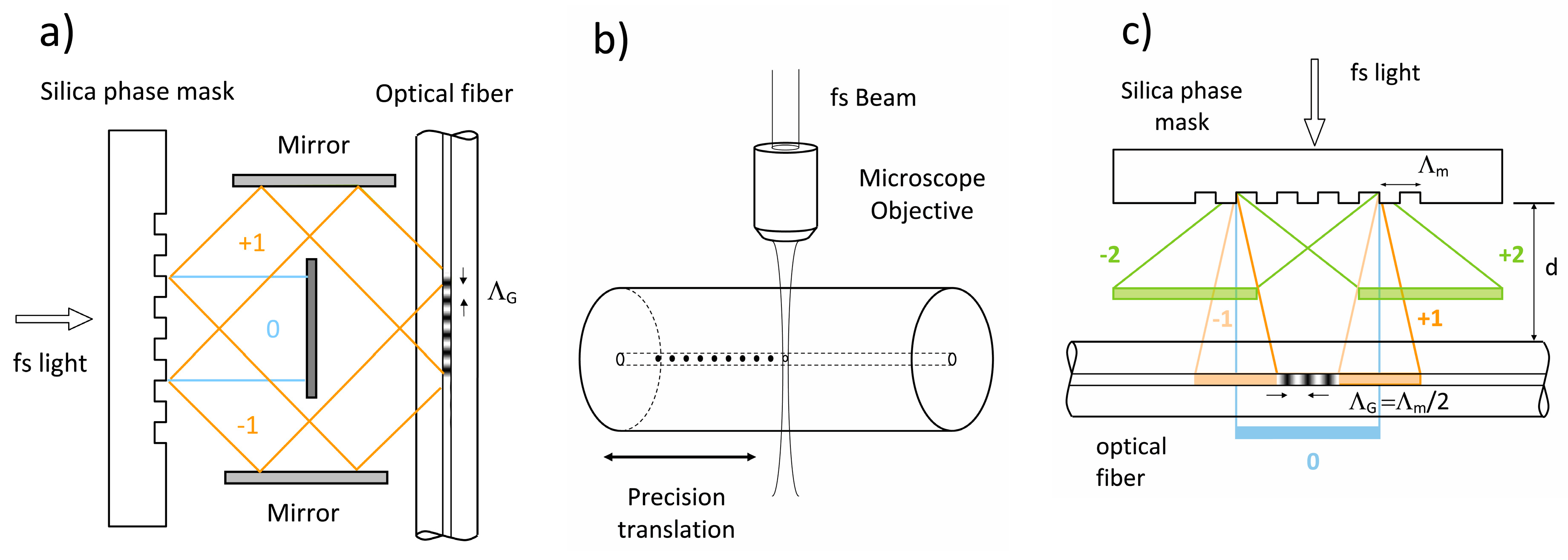




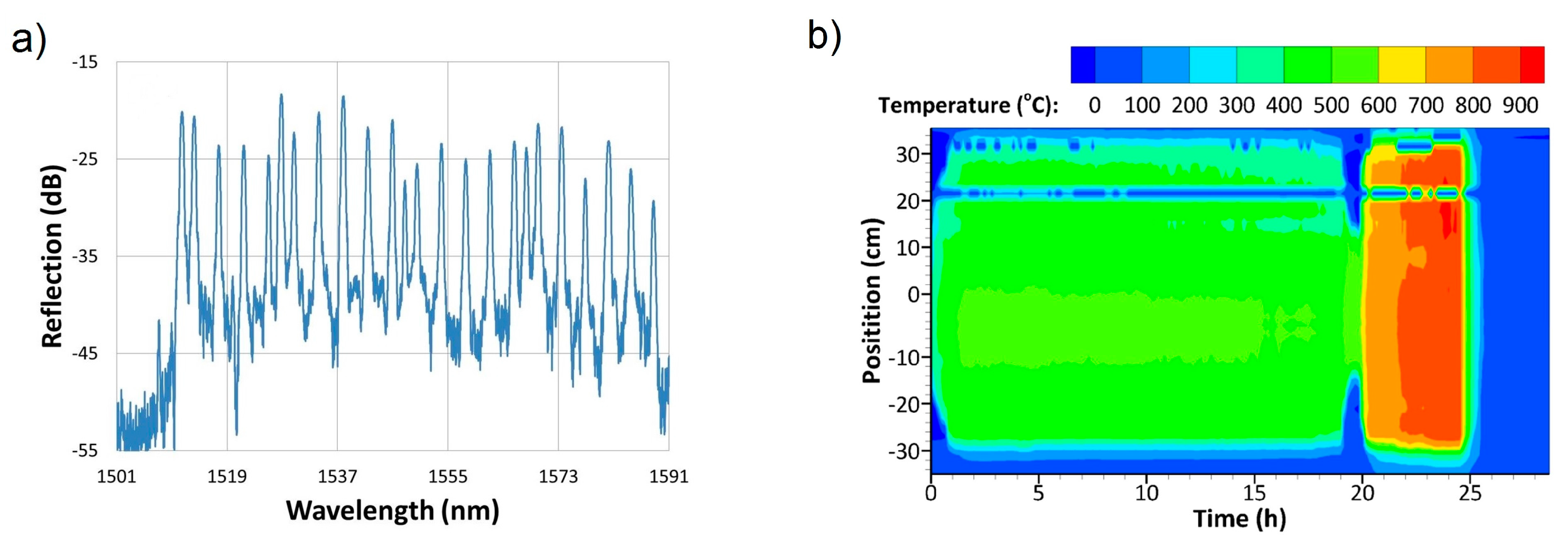
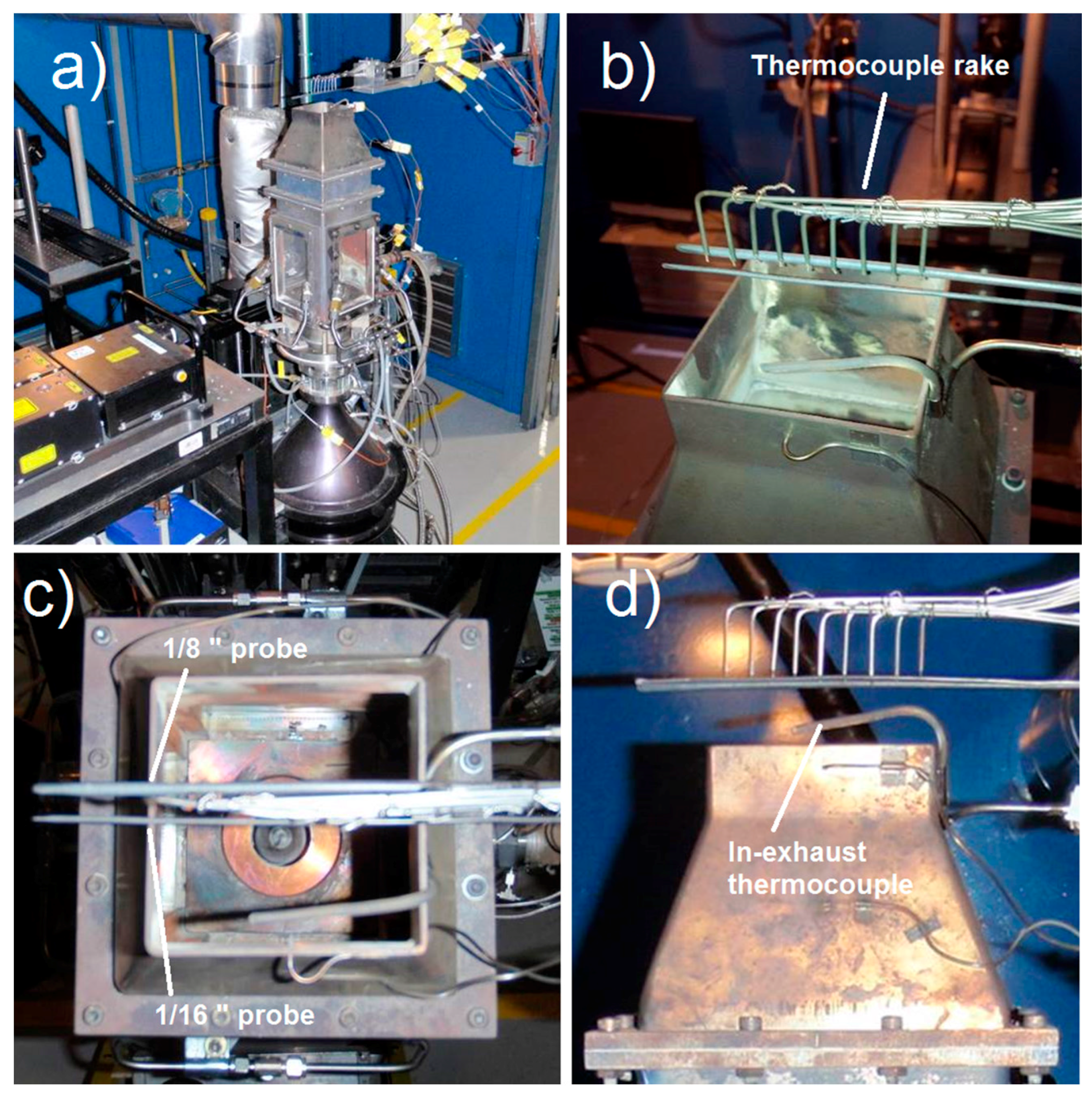



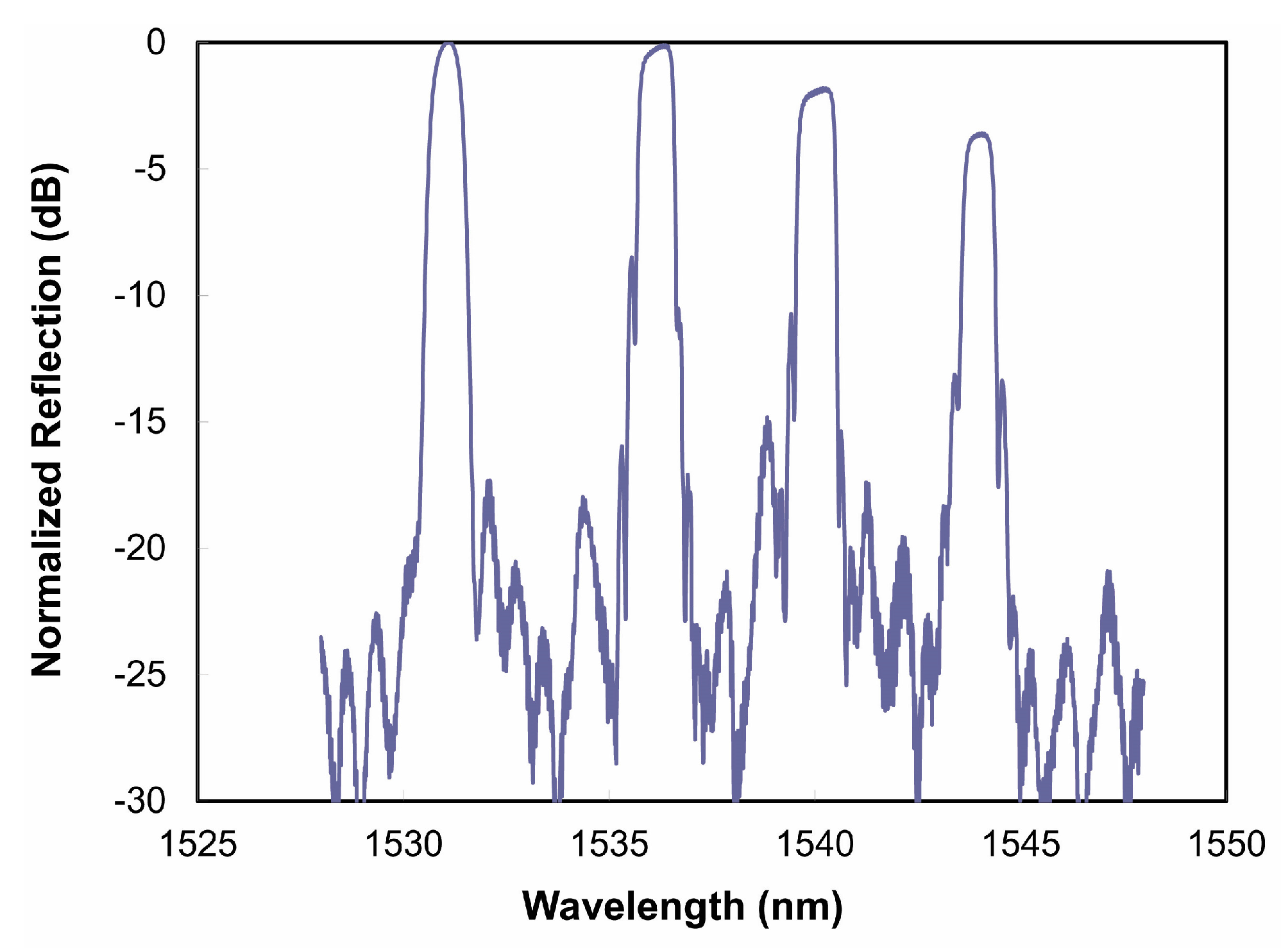
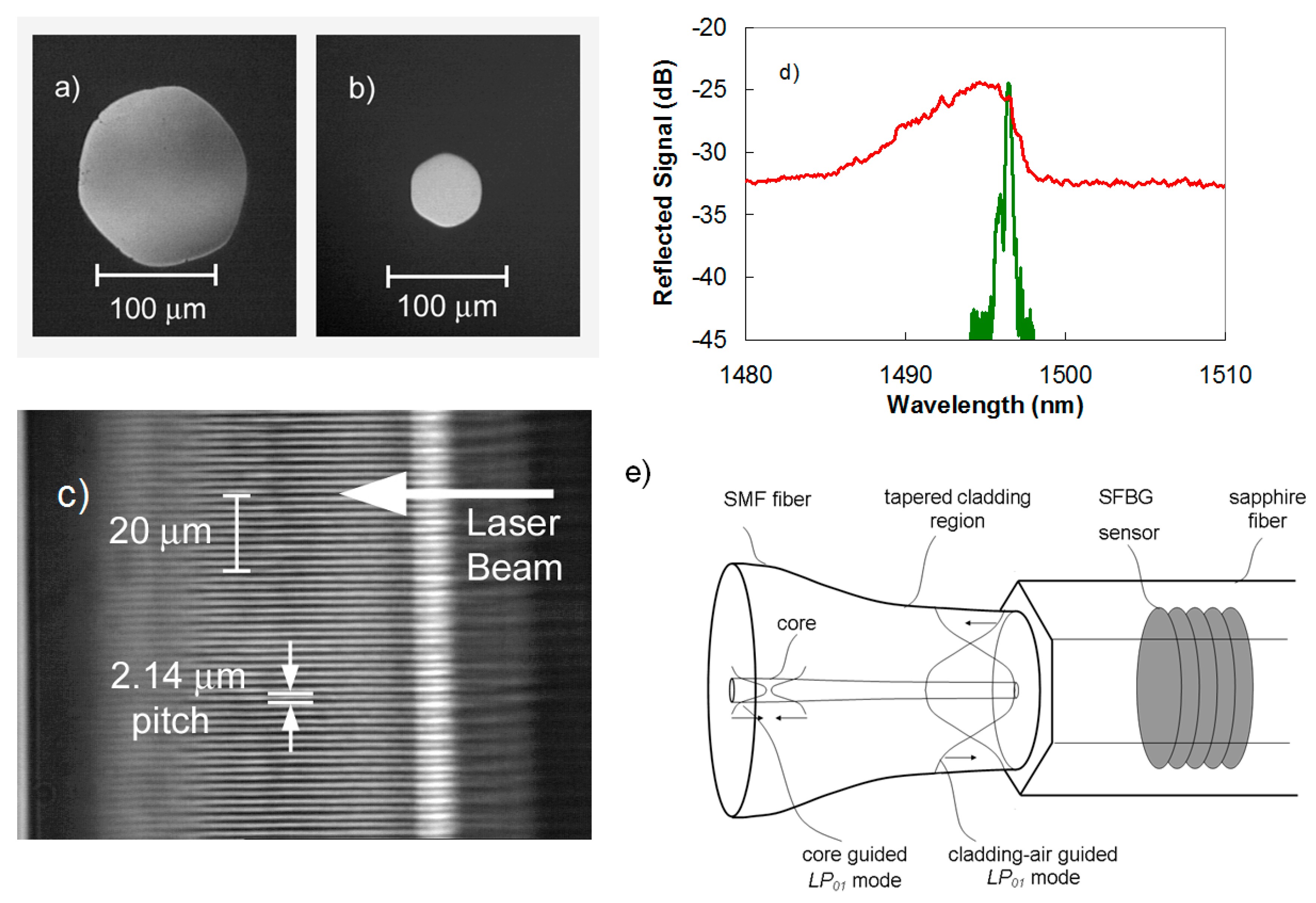


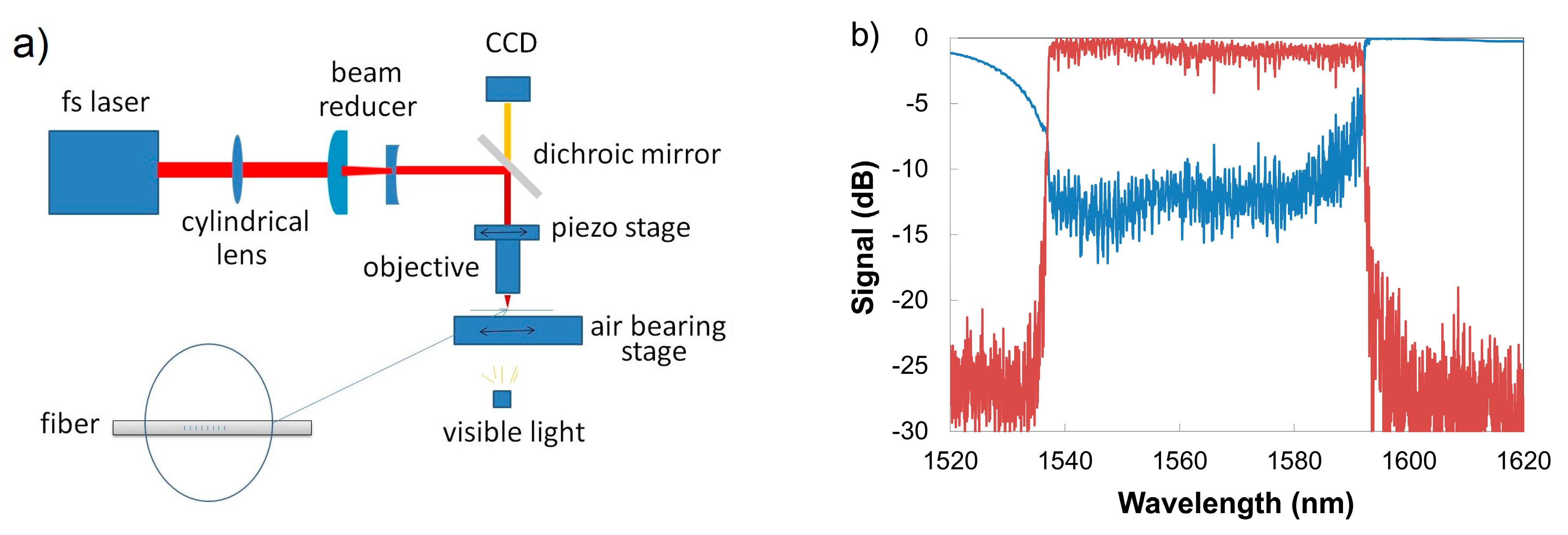
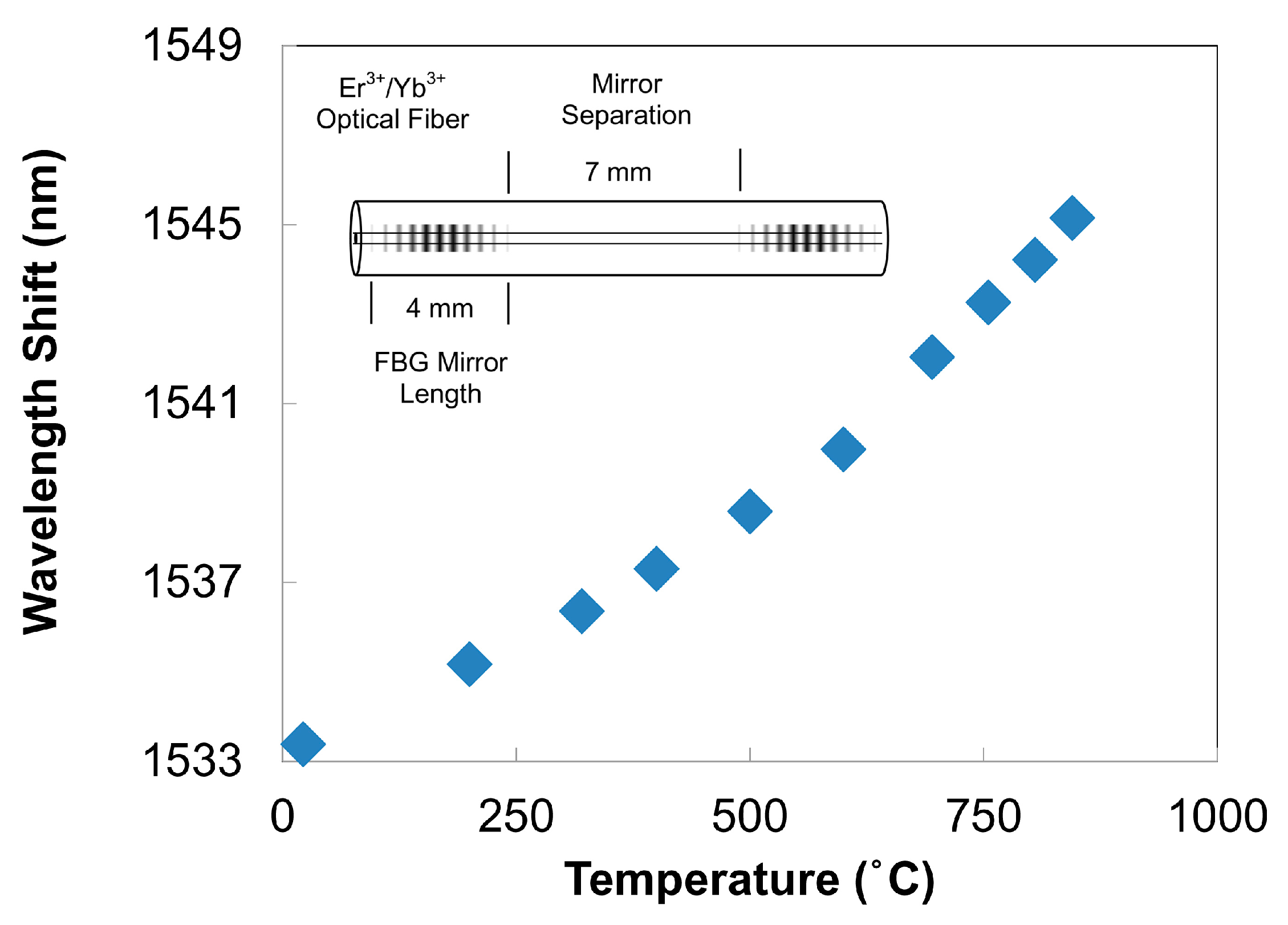
© 2017 by the authors. Licensee MDPI, Basel, Switzerland. This article is an open access article distributed under the terms and conditions of the Creative Commons Attribution (CC BY) license (http://creativecommons.org/licenses/by/4.0/).
Share and Cite
Mihailov, S.J.; Grobnic, D.; Hnatovsky, C.; Walker, R.B.; Lu, P.; Coulas, D.; Ding, H. Extreme Environment Sensing Using Femtosecond Laser-Inscribed Fiber Bragg Gratings. Sensors 2017, 17, 2909. https://doi.org/10.3390/s17122909
Mihailov SJ, Grobnic D, Hnatovsky C, Walker RB, Lu P, Coulas D, Ding H. Extreme Environment Sensing Using Femtosecond Laser-Inscribed Fiber Bragg Gratings. Sensors. 2017; 17(12):2909. https://doi.org/10.3390/s17122909
Chicago/Turabian StyleMihailov, Stephen J., Dan Grobnic, Cyril Hnatovsky, Robert B. Walker, Ping Lu, David Coulas, and Huimin Ding. 2017. "Extreme Environment Sensing Using Femtosecond Laser-Inscribed Fiber Bragg Gratings" Sensors 17, no. 12: 2909. https://doi.org/10.3390/s17122909




